For aspiring entrepreneurs, Shopify dropshipping with Alibaba offers an enticing opportunity to start an online business without the hassle of managing inventory. In this article, we’ll cover the basics of Shopify dropshipping, explain why Alibaba is an excellent supplier choice, and provide insights into product selection, store setup, order management, and effective marketing strategies.
We’ll also address common challenges, offer valuable tips for success, and answer critical questions to empower you for a prosperous e-commerce journey. Join us on this venture as we navigate the path to a thriving Shopify dropshipping business with Alibaba.
What is Shopify Dropshipping?
A popular eCommerce business strategy, known as “Shopify dropshipping,” involves creating an online store on the Shopify platform and selling products without holding physical inventory. Instead, you partner with suppliers who handle product inventory, packaging, and shipping directly to your customers. By taking care of various aspects of your business, such as marketing and growth, you can concentrate your efforts on promoting and expanding your business.
Why choose Alibaba as a supplier for your Shopify store?
Alibaba is one of the world’s largest B2B (business-to-business) marketplaces, connecting millions of suppliers with buyers. Alibaba serves a vast customer base of approximately 860 million people globally. In addition, the Alibaba website encompasses an impressive array of 5,900 distinct product categories and hosts about 2.8 million individual storefronts.
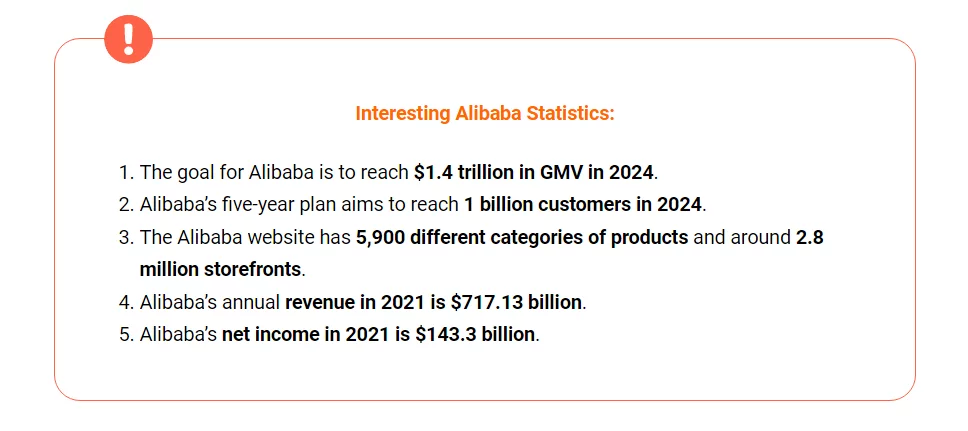
Source: FirstSiteGuide
Here are a few reasons why it is a popular choice for dropshipping entrepreneurs:
- Wide product selection: Alibaba offers various products across various categories, making finding the right products for your niche and target market easier.
- Competitive pricing: With numerous suppliers on Alibaba, you can compare prices and negotiate deals to ensure competitive pricing for your products.
- Supplier verification: Alibaba takes steps to verify suppliers and provides ratings and reviews from previous buyers, helping you choose reliable and trustworthy suppliers.
- Customization and branding: Alibaba suppliers offer private labeling and customization services to create a unique brand.
- Efficient shipping and logistics: Alibaba helps facilitate the shipping process, ensuring efficient delivery of products to your customers.
By leveraging the power of Shopify dropshipping and partnering with trusted suppliers on Alibaba, you can create a successful online store with minimal upfront investment and focus on growing your business.
Finding Products on Alibaba for Your Shopify Store
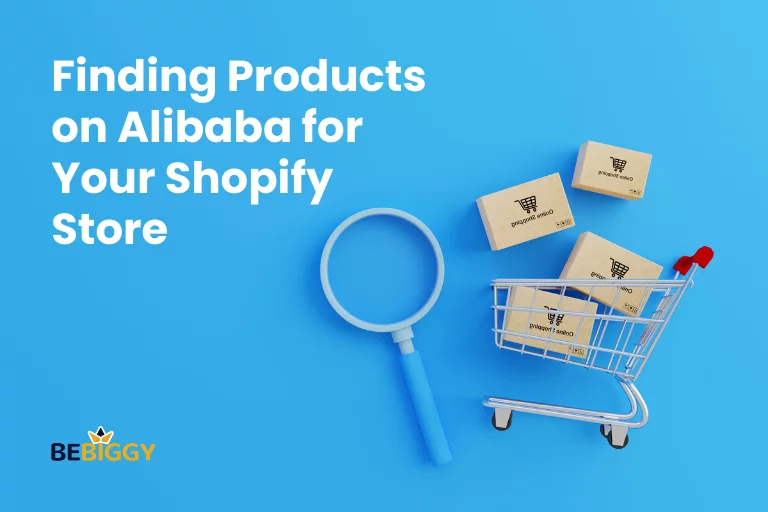
Finding reliable suppliers and high-quality products is essential when starting a Shopify dropshipping business. One platform that many entrepreneurs turn to is Alibaba, the world’s largest online B2B marketplace. By exploring the vast array of products available on Alibaba, you can find the perfect inventory for your Shopify store.
Exploring product categories on Alibaba
Alibaba offers various product categories, from electronics and clothing to beauty and home goods. To narrow your search, having a specific niche or target audience in mind is helpful. Focusing on a particular category can streamline your product selection process and cater to a specific customer base. Take the time to browse through different categories, explore trending products, and assess market demands to find the right products for your Shopify store.
Researching profitable products
Researching to find profitable products on Alibaba is essential for Shopify dropshipping success. It ensures you choose items with high demand, low competition, and strong growth potential, ultimately maximizing your chances of running a lucrative online store.
- Identify Potential Categories: Begin by pinpointing product categories that align with your business and customer base.
- Thorough Research: Conduct in-depth research to assess a product’s profitability by considering factors such as demand, competition, and growth potential.
- High Demand and Low Competition: Focus on products with high demand in the market but relatively low competition. This balance can increase your chances of success.
- Utilize Tools: Leverage various tools like Google Trends, keyword research, and competitor analysis to gauge market interest and identify potential gaps in the market.
- Data-Driven Decisions: Make informed decisions based on your research findings to select products likely to sell well on your Shopify store.
Selecting high-quality products
When selecting products on Alibaba, you must consider the quality of the products you intend to sell.
- Supplier Reliability: Choose suppliers known for offering high-quality products and aligning with your quality standards.
- Product Descriptions: Read product descriptions and specifications carefully to understand materials, manufacturing processes, and certifications adhered to by the product.
- Request Samples: Ask potential suppliers for product samples to evaluate quality firsthand before committing.
- Profit Margins: Calculate the total cost of the product, including shipping and additional fees, and compare it to the selling price on your Shopify store. Aim for products with reasonable profit margins while maintaining competitive pricing.
Factors to consider when choosing products on Alibaba for dropshipping
You can consider various vital factors when choosing products on Alibaba for dropshipping, such as::
- Size and Weight: Lightweight and small products are more cost effective to ship, reducing transportation expenses and increasing profit margins.
- Shipping Costs: Assess the costs associated with the chosen products to ensure they align with your budget and pricing strategy.
- Seasonality: Opt for products with consistent year-round demand to maintain steady sales and revenue, avoiding the challenges of seasonal fluctuations.
Tips for conducting due diligence on potential suppliers
Before finalizing a partnership with a supplier on Alibaba, it’s important to conduct due diligence.
- Reputation and Credibility: Research the supplier’s reputation and credibility by examining customer reviews and ratings.
- Response Rate and Communication Style: Assess the supplier’s response rate and communication style to ensure effective collaboration.
- Industry Experience: Verify the supplier’s experience in the industry, as more experienced suppliers tend to be more reliable.
- Client References: If available, request references from previous clients to gain insights into the supplier’s track record and reliability.
Contact potential suppliers
Once you have evaluated potential suppliers, reach out to them to discuss the terms of the partnership. Inquire about minimum order quantities, production times, and shipping options. Clarify any questions or concerns you may have regarding product customization or packaging. Building a solid relationship with your supplier is crucial for long-term success in your dropshipping business.
Setting Up Your Shopify Store for Dropshipping
Creating a Shopify account
The first step in setting up your Shopify dropshipping store is to create a Shopify account. Sign up for a Shopify account by providing basic business information, including store name, address, and contact details.
Installing and customizing your Shopify theme
Once you have signed up for a Shopify account, the next step is to install and personalize your Shopify theme. A theme plays a significant role in determining the overall appearance of your Shopify store. Therefore, selecting a theme that aligns with your brand and target audience is crucial. Shopify provides a vast range of free and paid themes that you can explore and install.
Once you have selected a theme for your online store, you can personalize it to align with your brand by incorporating your logo, modifying fonts and colors, and arranging the layout of your homepage. It’s crucial to optimize your store for mobile devices because more shoppers are using smartphones to make purchases.
When you set up a Shopify store for dropshipping, you can source products from Alibaba suppliers, create your online store, and market to potential customers. With the right strategy and attention to detail, Shopify dropshipping with Alibaba can be a profitable opportunity for entrepreneurs in the e-commerce space.
Alibaba and Shopify Integration
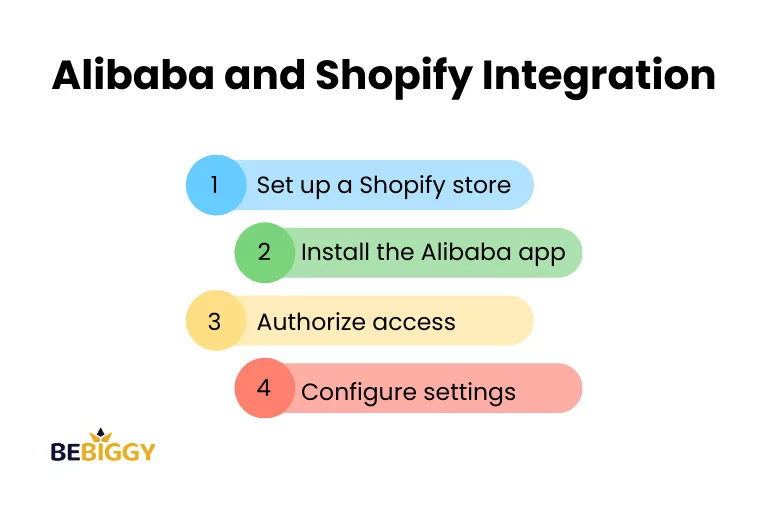
Connecting your Alibaba and Shopify accounts
If you are running a dropshipping business on Shopify, integrating with Alibaba can open up opportunities. To connect your Alibaba and Shopify accounts, follow these simple steps:
- Set up a Shopify store: If you don’t already have one, create one and set up the necessary payment and shipping settings.
- Install the Alibaba app: Go to the Shopify App Store and search for the Alibaba app. Install the app and follow instructions to connect with your Shopify store.
- Authorize access: Once the app is installed, authorize access to your Alibaba account by entering your credentials.
- Configure settings: Customize the settings according to your business needs. You can choose which products to import from Alibaba, set pricing rules, and manage inventory synchronization.
Syncing product information and inventory
Integrating Alibaba with your Shopify store lets you easily sync product information and inventory in real-time. Here’s how it works:
- Import products: Use the Alibaba app to browse and import products from Alibaba to your Shopify store. You can import individual products or entire product catalogs.
- Manage pricing and inventory: Set your own prices for the imported products and add them to your store. The app will automatically sync inventory levels, ensuring that your customers can only purchase products that are in stock.
- Order fulfillment: When a customer places an order on your Shopify store, the app automatically transmits the order details to the supplier on Alibaba. The supplier will directly deliver the product to the customer, eliminating the need for inventory and logistics management.
With Alibaba and Shopify integration, you can tap into a vast network of suppliers and expand your product offerings without the hassle of inventory management. Start exploring the opportunities today!
Creating Product Listings
Creating and customizing product listings is fundamental to building a successful Shopify dropshipping business with Alibaba. Your product listings serve as the virtual storefront for your e-commerce business. They are what potential customers see, interact with, and ultimately make purchase decisions based on. To ensure your product listings are effective and appealing, follow these essential steps and strategies:
- Detailed and Engaging Product Descriptions
Product descriptions are your opportunity to communicate the value and benefits of your products. They should be detailed, informative, and engaging. Use descriptive language, highlighting key features, specifications, and unique selling points. The goal is to help potential customers fully understand what they’re considering purchasing.
- High-Quality Images
To attract and retain customers, focusing on the visual aspect is essential. It is essential to use high-quality images that showcase the product from various angles. It is also important to include clear images of any product variations or options. This will give customers a comprehensive and clear visual understanding of their purchasing.
- SEO Optimization
Search engine optimization (SEO) isn’t just for websites; it’s also relevant to product listings. Improving your product visibility in search results by using relevant keywords in titles and descriptions can increase organic traffic to your store.
- Product Variations and Options
Include these options in your listings if your products have variations, such as different sizes, colors, or styles. Customers appreciate having choices, and providing various product options can boost your sales.
- Customer Reviews and Ratings
Incorporate customer reviews and ratings when possible. Positive feedback and high ratings build trust with potential customers. If you’re starting, encourage your first customers to leave reviews after their purchases.
- Mobile Responsiveness
With the increasing use of mobile devices for online shopping, ensure that your product listings are mobile-responsive. They should display and function well on various screen sizes and devices.
- Regular Updates
The e-commerce landscape is dynamic. Keep your product listings up to date, reflecting any changes in your product offerings, pricing, or market trends.
Managing Orders and Shipping
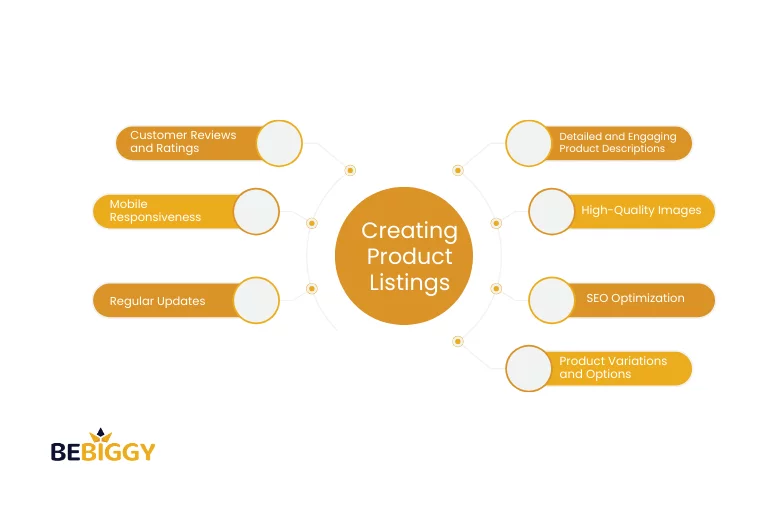
Processing customer orders with Alibaba suppliers
One of the key advantages of working with Alibaba suppliers is the ability to process customer orders efficiently. Considering the vast array of products available, you can readily locate suppliers that provide dropshipping services.
This means that when a customer places an order on your Shopify store, you can forward that order to your chosen Alibaba supplier, who will then handle the packaging and shipping directly to the customer. This step-by-step process ensures that orders are fulfilled promptly and allows you to focus on marketing and growing your business.
- Customer Places an Order: The process begins when a customer places an order on your Shopify store.
- Order Confirmation: The customer will receive both an email and a Shopify admin notification confirming their order details.
- Automated Order Forwarding: If you have set up automated order forwarding or use dropshipping apps, the order details are automatically sent to your Alibaba supplier.
- Supplier Acknowledgment: The Alibaba supplier acknowledges the order and initiates the fulfillment process.
- Product Packaging and Preparation: The supplier prepares the ordered products for shipping. This includes quality checks, packaging, and labeling.
- Shipping Information: The supplier provides you with the shipping information, including tracking numbers and estimated delivery times.
- Update Customer: You email the customer the shipment details and expected delivery date, building transparency and trust.
- Order Shipment: The supplier ships the products directly to the customer’s address.
- Customer Receives the Order: The order is delivered to the customer, who accepts it.
- Order Completed: In your Shopify admin, mark the order as completed, and the customer’s payment is processed.
Handling returns and refunds
Having a clear returns and refunds process is essential for any e-commerce business. When working with Alibaba suppliers, it’s crucial to establish clear communication and agreements regarding returns and refunds. Make sure to discuss these policies with your suppliers before starting the partnership. This will help you handle any potential issues and provide a satisfactory resolution to your customers.
Partnering with Alibaba suppliers can offer great opportunities for managing orders and shipping in your Shopify dropshipping business. By leveraging their expertise and infrastructure, you can provide a seamless experience for your customers and build a reputable brand. Remember to establish clear communication and agreements with your suppliers, and continuously monitor and improve your processes to ensure customer satisfaction.
Marketing Your Shopify Store and Products

Creating effective marketing strategies
When it comes to dropshipping with Alibaba on Shopify, effective marketing strategies are crucial to ensure your store and products gain visibility and attract customers. Here are some key tips to help you create successful marketing campaigns:
- Targeted Advertising: Understand your target audience and create tailored advertisements that resonate with their needs and interests. This could include using demographic filters, keywords, and interests to reach the right people.
- Compelling Content: Create engaging and informative content that showcases your products’ benefits and unique features. Use high-quality visuals, persuasive copywriting, and customer testimonials to build trust and drive conversions.
- Email Marketing: Create a mailing list and regularly send tailored emails to subscribers. This helps in nurturing relationships and encouraging repeat purchases.
Utilizing social media and influencer marketing
Social media and influencer marketing can help reach a wider audience and drive sales. Here are some strategies to leverage these platforms effectively:
- Social Media Advertising: Target potential customers on platforms like Facebook, Instagram, and Pinterest with targeted ads. Use eye-catching visuals, compelling captions, and appropriate hashtags to maximize engagement.
- Influencer Collaborations: Partner with relevant influencers who have a strong following in your niche. Featured sponsored posts, reviews, and giveaways can expand reach and credibility.
- User-Generated Content: Encourage customers to share their product experiences on social media using brand hashtags. Repost their content and engage with them, turning satisfied customers into brand advocates.
By adapting these strategies to your specific business and target market, you can effectively market your Shopify store and products, increasing traffic, sales, and long-term growth.
Scaling Your Shopify Dropshipping Business
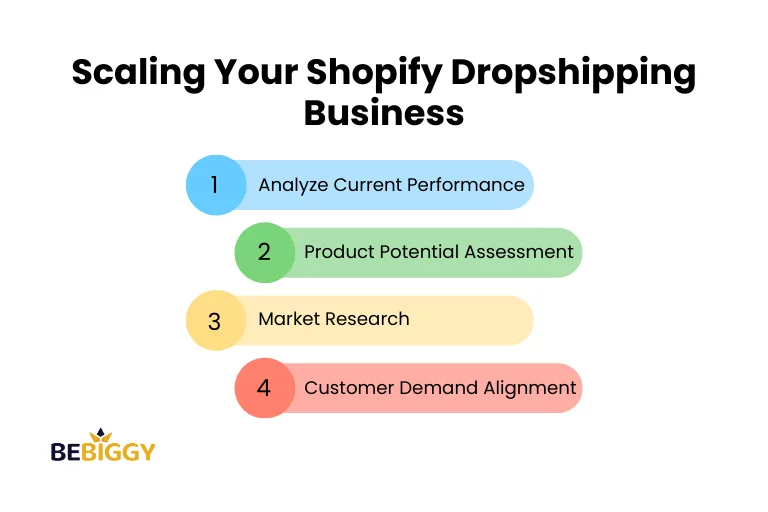
Identifying opportunities for growth
When it comes to scaling your Shopify dropshipping business, identifying the right opportunities for growth is crucial. There are various ways to do this, including:
- Analyze Current Performance: Examine your sales data, customer feedback, and market trends to assess the performance of your existing products. Identify best-selling items and areas that need improvement.
- Product Potential Assessment: Determine which products hold the potential to become best sellers by evaluating their market demand, customer interest, and sales history.
- Market Research: Stay informed about industry news, conduct competitor analysis, and track emerging trends in your niche to keep your business ahead of the curve.
- Customer Demand Alignment: Understand customer preferences and needs to effectively align your product offerings with market demands. This involves tailoring your inventory to meet specific customer desires.
Expanding product range and targeting new markets
If you want to grow your dropshipping business, one strategy to consider is to broaden your product selection. This can help you attract more customers and boost your sales.Expanding your reach and maximizing your earning potential can be very helpful. Consider adding complementary products that appeal to your current customer base or explore new niches that align with your brand and target audience. This can increase your chances of cross-selling, upselling to existing customers, and attracting new ones.
Expanding into new markets can broaden your audience and increase sales potential. Research different demographics, regions, or even international markets that may have a demand for your products. Consider adapting your marketing strategies, product descriptions, and even offering multilingual support to cater to these new markets effectively.
By keeping up with market trends through innovation, you can maintain competitiveness and drive growth for your Shopify dropshipping business. Remember to monitor your progress, analyze data, and adjust your strategies to maximize your success.
Pros and Cons of Dropshipping With Alibaba
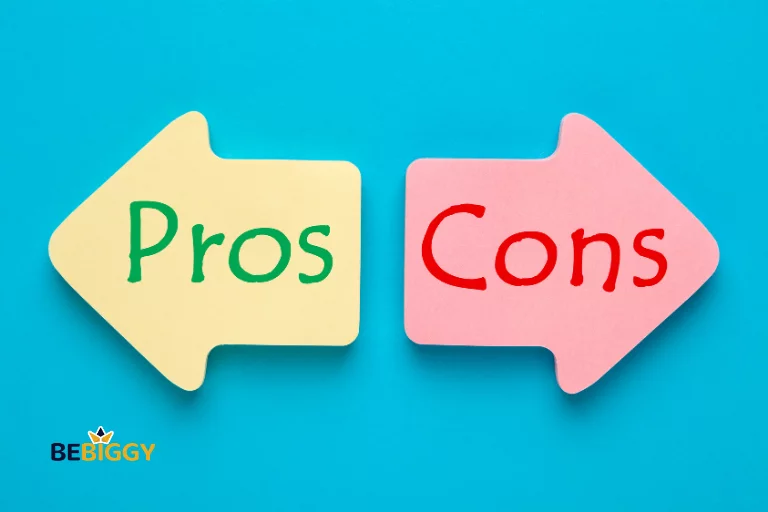
Shopify dropshipping with Alibaba offers several advantages and disadvantages that entrepreneurs should carefully consider before venturing into this business model. Let’s explore some of the key pros and cons:
Pros:
- Low Initial Investment: Dropshipping requires minimal upfront investment as you don’t need to purchase inventory. This allows you to start your online store with relatively low capital.
- Wide Product Selection: Alibaba boasts an extensive range of products from various categories. This diversity allows you to choose products that align with your niche and cater to different customer preferences.
- Scalability: As your business expands, you can effortlessly increase your operations without the burden of managing inventory. Shopify’s integration with Alibaba simplifies order fulfillment and makes it efficient.
- Global Reach: Alibaba connects you with suppliers from around the world. This means you can source products internationally and access a global customer base.
- Competitive Pricing: Alibaba often offers products at competitive prices, which can improve your profit margins. You can find products at different price points to cater to a broader audience.
- Shipping and Fulfillment Options: Alibaba suppliers typically offer various shipping and fulfillment options, including dropshipping services. With this feature, you can select the most suitable methods for your customers.
Cons:
- Quality Control: Ensuring the quality of products can be challenging when you don’t physically handle inventory. Relying on suppliers to maintain consistent quality may result in occasional issues.
- Shipping Times: International shipping can lead to longer delivery times, which may affect customer satisfaction. Slow shipping can lead to higher cart abandonment rates.
- Intense Competition: Dropshipping is a popular business model, and many entrepreneurs choose Alibaba as their source. This can lead to intense competition, making it vital to stand out in the market.
- Supplier Reliability: Alibaba hosts a mix of reliable and less reputable suppliers. It’s crucial to vet and choose trustworthy suppliers to avoid potential complications.
- Customer Service: Since you don’t have control over shipping and handling, dealing with customer service issues, such as lost packages or damaged goods, can take time and effort.
- Lack of Brand Control: In the dropshipping model, you often sell products under your brand but need more control over the product itself. This can impact brand reputation and customer trust.
Shopify dropshipping with Alibaba can be a lucrative business opportunity for those who navigate its complexities. Entrepreneurs should weigh pros and cons, and develop strategies to mitigate challenges, ensuring a successful e-commerce venture.
Challenges and Tips for Success in Shopify Dropshipping with Alibaba

Common challenges faced by dropshippers
Starting a Shopify dropshipping business using Alibaba as a sourcing platform can be profitable, but it’s challenging. Here are some common hurdles you may encounter:
- Product Quality: One of the biggest concerns when dropshipping from Alibaba is ensuring the products you sell meet high-quality standards. To mitigate financial risks, selecting suppliers with a proven track record and positive customer reviews is important.
- Shipping and Delivery: Shipping times can often be long, particularly if your supplier is located in China. Look for alternative suppliers or plan ahead to account for longer delivery times. Customers expect fast shipping, so managing their expectations and clearly communicating delivery timeframes is important.
- Competition and Niche Selection: Dropshipping is a popular business model, meaning significant competition exists in many niches. To stand out and succeed, finding a unique niche or focusing on specific products with less competition is essential.
Tips and advice for a successful business
While challenges may exist, there are ways to overcome them and thrive as a Shopify dropshipper using Alibaba. Here are some tips for success:
- Thoroughly Research Suppliers: Spend time researching potential suppliers on Alibaba. Choosing suppliers with a positive reputation, excellent reviews, and a history of consistently delivering quality products on time is important.
- Test Products: Order product samples to assess quality and anticipate any issues before purchasing.This way, you can ensure you are offering products that meet your customers’ expectations.
- Build a Strong Brand: Differentiate your business by building a strong brand identity. To establish trust and loyalty, focus on creating a professional website, compelling product descriptions, and excellent customer service.
- Optimize your Shopify Store: Enhance your store’s visibility by optimizing it for search engines. Optimize product images, descriptions & content to engage audience with relevant keywords.
- Market your Store: Use social media advertising, influencer collaborations, and email campaigns to generate traffic and attract potential customers.
By implementing these tips, you can increase your chances of success as a Shopify dropshipper using Alibaba for sourcing products and build a profitable online business.
FAQs on Shopify Dropshipping with Alibaba

Is Alibaba legit?
Yes, Alibaba is a legitimate e-commerce platform. It is one of the largest online marketplaces in the world, connecting buyers and sellers for various products and services. However, the legitimacy of individual sellers and products on Alibaba can vary, so buyers should exercise caution and verify the credibility of the specific seller they are dealing with.
Can you dropship from Alibaba to Shopify?
Yes, you can dropship products from Alibaba to your Shopify store. Many businesses use this model, but it requires careful selection of reliable suppliers and effective management of your online store.
Can I add products from Alibaba to Shopify?
Yes, adding products to your Shopify store from Alibaba is easy by importing listings or adding them manually. This allows you to sell Alibaba-sourced products on your Shopify platform.
Can you wholesale on Alibaba?
Yes, you can wholesale products on Alibaba. Alibaba offers a range of options for bulk purchasing and sourcing products in large quantities from suppliers and manufacturer.
Is it safe to use Alibaba?
Yes, The safety of using Alibaba depends on various factors, including your due diligence in researching and vetting suppliers and products. While many legitimate businesses operate on Alibaba, there are also scams and fraudulent sellers, so caution and research are essential for safety.
How do you start dropshipping from Alibaba to Shopify?
- Research and select a niche for your dropshipping business.
- Create a Shopify store and personalize it as you see fit.
- Register your business and set up a legal and financial framework.
- Find reliable Alibaba suppliers and negotiate terms.
- Import products from Alibaba to your Shopify store.
- Set competitive pricing and appealing product listings.
- Configure a payment gateway for customer transactions.
- Establish shipping and return policies.
- Create a marketing tactic to drive traffic to your store.
- Provide excellent customer service and support.
- Continuously monitor and adjust your business strategy.
How to add products from Alibaba to Shopify?
- Contact Alibaba suppliers to discuss product details and availability.
- Obtain product images, descriptions, and pricing from suppliers.
- Log in to your Shopify admin panel.
- Go to the “Products” section and select “Add product.”
- Enter the product details, including title, description, and images.
- Set pricing based on your negotiation with the Alibaba supplier.
- Specify product variants and manage inventory.
- Indicate that the supplier will fulfill the product or set up your preferred shipping methods.
- You can save the product as a draft or publish it to your store.
- Repeat the process for each product you want to add from Alibaba to Shopify.
Conclusion
Whether you are a new entrepreneur or an experienced business owner looking to expand your product offerings, Shopify Dropshipping with Alibaba can be a lucrative opportunity. This combination empowers you to access a vast range of products and connect with dependable suppliers worldwide. By utilizing the dropshipping model, you can eliminate the need for inventory management and focus on growing your business.
Final thoughts and next steps
If you’re considering Shopify Dropshipping with Alibaba, take the time to research your target market, competitors, and product demand. Conduct thorough due diligence when selecting suppliers to ensure reliability. To effectively promote your products and attract customers, creating a comprehensive marketing plan is important.
This plan should include various strategies such as advertising, social media, influencer collaborations, email marketing, and more Implementing a comprehensive marketing strategy can increase brand awareness, target your audience more effectively, and ultimately drive sales. Stay updated on industry trends and constantly optimize your store for better conversions.
Remember that success in dropshipping requires dedication, persistence, and continuous improvement. By leveraging the power of Shopify and Alibaba, you can turn your entrepreneurial dreams into a profitable reality. Start exploring the opportunities today and embark on your dropshipping journey!












 What Is Shopify Dropshipping and How Does It Work?
What Is Shopify Dropshipping and How Does It Work? 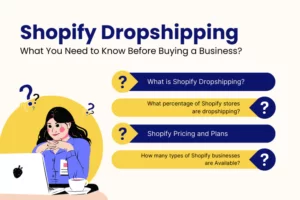 Shopify Dropshipping: What You Need to Know Before Buying a Business?
Shopify Dropshipping: What You Need to Know Before Buying a Business?  How to Dropship on Shopify: Step-by-Step Guide
How to Dropship on Shopify: Step-by-Step Guide  Guide to Finding Reliable Shopify Dropshipping Suppliers [100% Success]
Guide to Finding Reliable Shopify Dropshipping Suppliers [100% Success]